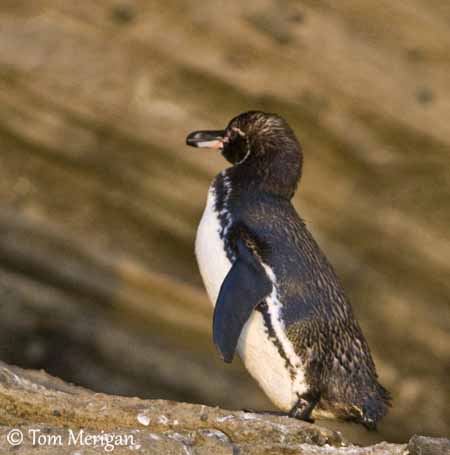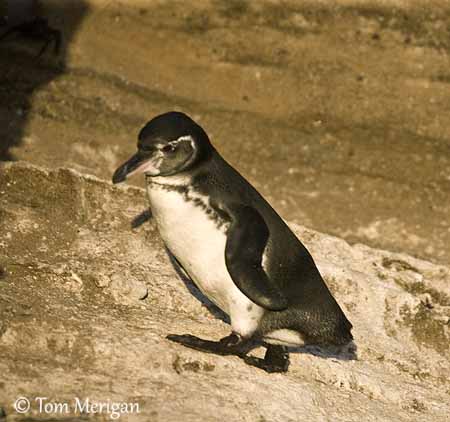
Fr: Manchot des Galápagos
All : Galapagospinguin
Esp : Pingüino de las Galápagos
Ital : Pinguino delle Galapagos
Nd : Galápagospinguïn
Sd : Galapagospingvin
Photographers:
John Anderson
John Anderson Photo Galleries
Tom Merigan
Tom Merigan’s Photo Galleries
Text by Nicole Bouglouan
Sources:
HANDBOOK OF THE BIRDS OF THE WORLD vol 1 by Josep del Hoyo-Andrew Elliot-Jordi Sargatal - Lynx Edicions - ISBN: 8487334105
BirdLife International (BirdLife International)
Animal Diversity Web (University of Michigan Museum of Zoology)
Penguins of the world (Mike Bingham)
Les Manchots (François Durand)
ANIMALS – Explore, discover, connect
Galapagos Penguin
Spheniscus mendiculus
Sphenisciforme Order – Spheniscidae Family
INTRODUCTION:
The Galapagos Penguin is the smallest species of this family, and endemic to the Galapagos Islands. It is the only penguin living on the equator with nesting habitat such as volcanic caves or cracks in rocks.
These penguins often form groups during the breeding season, for movements or feeding behaviour. Flocks may contain 50 to 200 birds when fishing and their movements are synchronized when they move in unison.
Cool temperatures from Humboldt Current and cool waters from Cromwell current help them to survive in Galapagos Islands, sometimes too warm for them.
DESCRIPTION OF THIS BIRD:
Biometrics:
Length: 48-53 cm
Weight: 1700-2600 g

The adult has black upperparts and white underparts. On the black head, we can see a narrow white line running from lores, above the eye, bordering ear-coverts and cheeks and joining the throat.
The underparts are white, bordered with broader black line, from upperbreast down to the short legs.
The bill shows black upper mandible and tip, and pink lower mandible. The eyes are dark brown, surrounded by narrow pinkish bare skin. Legs and webbed feet are blackish, like the long flippers.
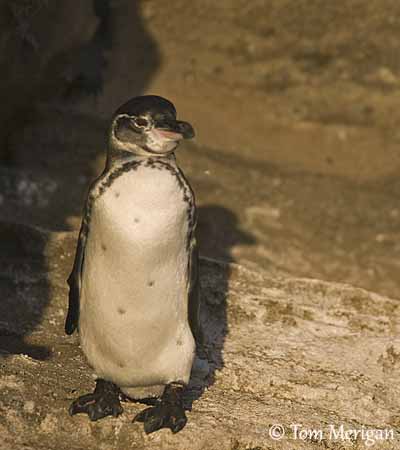
Male and female are similar in plumage, but the female is smaller.
The juvenile has dark grey upperparts. On the head, chin, throat, cheeks and ear-coverts are white. The broad black line of the underparts is absent.
The chick is protected from sun and cold by thick brown plumage above and white below, developed at about one month of age.
The Galapagos Penguin has two moults per year, with a complete moult before breeding. At this moment, they stay out of the water.

RANGE:
The Galapagos Penguin is found in Galapagos Islands. It breeds on Isabela, Fernandina and probably Bartholomew.
HABITAT:
The Galapagos Penguin nests in caves and cracks in lava, usually near sea-level. It feeds near the shore in areas of cool, nutrient-rich waters where it can find abundant preys all year round.
CALLS AND SONGS: SOUNDS BY XENO-CANTO
The Galapagos Penguin has both visual and vocal well developed communication systems. The voice plays an important role in helping to recognize adults and chicks. Body movements often accompany these calls and are used in nest-defence, courtship displays and general communication.
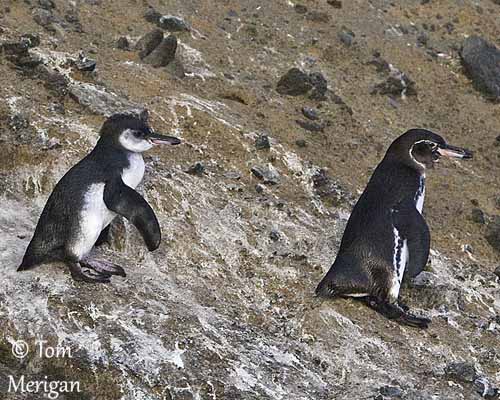
Juvenile on the left
Adult on the right
BEHAVIOUR IN THE WILD:
The Galapagos Penguin feeds on numerous types of small fish of 10-150mm long. It also takes various small marine invertebrates. Fish preys are anchovies, sardines, pilchards and mullets.
They often forage in pairs, using the long flippers to swim underwater. The small preys are caught with the bill.
But the Galapagos Penguin may also perform co-operative fishing at shoals. They capture the preys from below, thanks to the position of the eyes in relation to the bill. The main preys are fish, molluscs, crustaceans, various marine invertebrates and zooplankton.
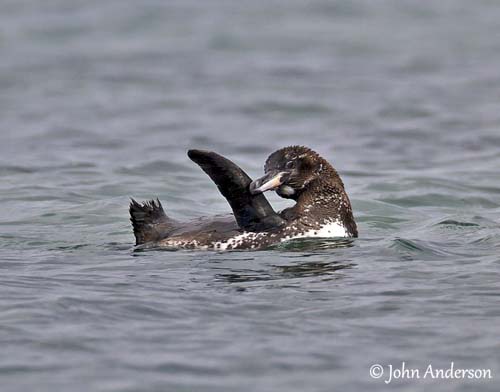
The Galapagos Penguin breeds all year round. They are territorial, but depending on the density of the colony. They adjust the breeding period during the best local conditions which provide them available food resources.
They nest in small, fairly loose colonies and are monogamous, but they also nest in small groups or solitary.
Some displays are performed to deter egg predators. The Galapagos Penguin calls while flapping its flippers against the flanks. During courtship rituals, it uses displays and postures which help to attract a mate in non-paired birds, or to strengthen the pair-bonds between paired mates. Courtship rituals include mutual preening, flipper patting and bill duelling. Body movements and vocalizations are used for all types of communication.
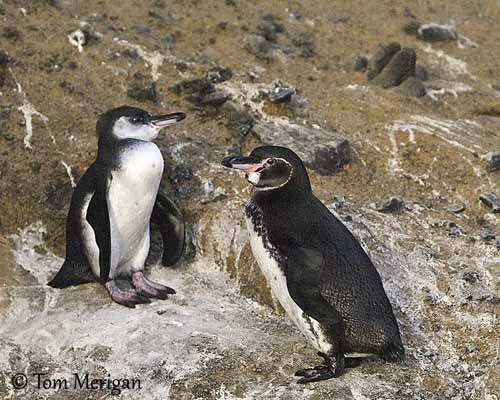
The Galapagos Penguin is sedentary in its range, or may be vagrant to Panama.
Of course, it does not fly! However, it is very agile in the water. If the flat wings are useless for flight, they are able to propel the bird through water, because penguins do not use their webbed feet as paddles, but more as rudder. Their plumage is highly waterproof and their body is streamlined.
The Galapagos Penguin performs three types of movements in the water, such as “surface swimming”, “underwater flying”, and “porpoising” during which the penguin performs an undulating movement, flopping in and out of water at regular intervals. But the latter is infrequent in this species.
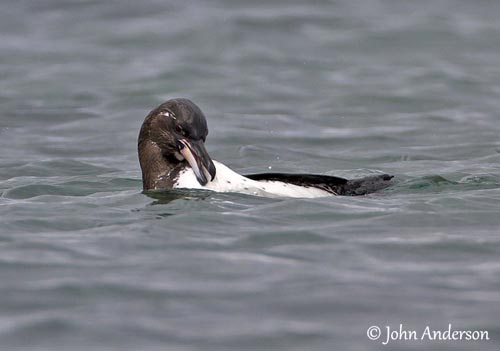
REPRODUCTION OF THIS SPECIES:
The Galapagos Penguin can breed 2-3 times a year, but mainly between May and July. The pair builds the nest before the copulation. The nest is made in crack or cave in lava, or in rock crevice, but always shaded from sunlight.
The female lays one or two eggs and both parents incubate during 38-40 days. The non-incubating bird forages for food in coastal waters. The chick is fed by regurgitation. Guarding and feeding activities last about 30-40 days. Then, the chick is left alone while the adults are foraging, and this period lasts one month. At this moment, the well grown chick is almost adult. It is independent within 3-6 months.

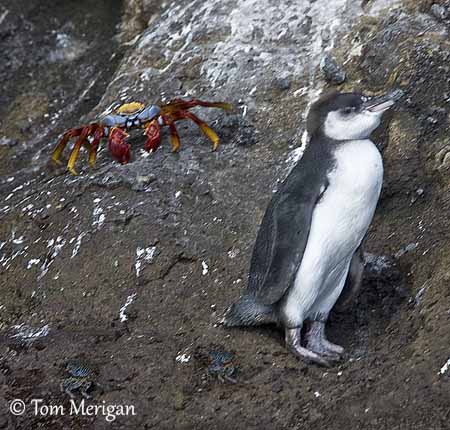
Sally Lightfoot Crab
Grapsus grapsus
PROTECTION / THREATS / STATUS:
The Galapagos Penguin is classified as Endangered Species.
This species has suffered dramatic declines in recent decades, due to El Niño. The recovery phase has been slow but now, populations are relatively stable but reduced.
Penguins are also threatened by change of surface water temperatures, diseases, oil pollution, predation by introduced cats, and floating fishing nets which may drown penguins. Disturbances by increasing human populations and tourists exacerbate these yet existing threats.
The Galapagos Penguin’s populations occur mainly in Galapagos National Park and Marine Reserve, where they are monitored, and predators are controlled.
Long-term monitoring programs and conservation measures are currently active.
